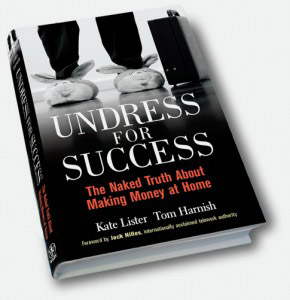Introduction
Undress For Success:
The Naked Truth About Making Money at Home
Introduction
Are you sick of the rat race? Do you feel like your life is out of control? Are you tired of the time and money you waste commuting?
You’re not alone. The majority of U.S. employees would eagerly trade their business suits for sweat suits if they could find a way to work from home. Already, for about 26 million Americans, work is what they do, not where they go.
Way back in 1970 Alvin Toffler understood the problem. In Future Shock he wrote, ‘‘In a country that has been moaning about low productivity and searching for new ways to increase it, the single most antiproductive thing we can do is ship millions of workers back and forth across the landscape every morning and evening.’’
Does dressing up and going to an office make you any smarter? Speaking for myself, I can almost feel my I.Q. go down as I pull my pantyhose up. And what’s with neckties? Who decided a tourniquet around an executive’s brainstem was a good idea?
Does sitting in an office with a gaggle of people make you more productive? Between the obligatory coffee-corner blather, interminable meetings, two-hour lunches, football pools, birthday parties, and cubicle gossip, it’s a wonder anything gets done.
To be fair, some folks enjoy the social aspects of office life. They’re content with life on the cubicle farm. They like being corralled by the nine-to-five routine and enjoy the time away from home. But if, like me, you’re happy to hammer away at your keyboard in solitude, you’re eager to shed your business duds, and you yearn for more control over your life, this book is for you.
I remember the polished feeling as I greeted each day in my tailored suit—and the punished feeling after ten hours in Philadelphia’s summer swelter. I remember the intrigued feeling as I set out for important meetings—and the fatigued feeling that followed the blah, blah, blah that ensued. I remember the ‘‘I’ve arrived’’ feeling when I bought my first Mercedes—and the ‘‘I’m gonna die!’’ feeling as I navigated the SureKill Expressway on the way to work.
A keen sense of the obvious told me the conventional job scene was not for me, so I set out on my own. Over the past 25 years, I’ve run several successful businesses from the comfort of my own home, and couldn’t be happier.
The last 16 of those years, Tom and I owned and operated a vintage airplane ride business, mostly from home. We had seven historic aircraft, 25 pilots, and three virtual staffers. We chose to run the business, for the most part, in our underwear. A reporter once asked: ‘‘So what inspired you to start this business?’’ My answer—on live TV—was, ‘‘Pantyhose. I can’t stand ’em.’’
We sold that business in 2006, and while initially retirement beckoned, we quickly burned out on life in the slow lane. So we set our computers in search of something that would allow us to continue to work, if not au naturel, at least in comfy clothes. Google didn’t disappoint. It found 1.6 million work-at-home opportunities and another 2.2 million home business ideas. Gulp—we’d be eligible for social security before we’d make a dent in the list.
We engaged our b.s. detectors and quickly realized that finding legitimate at-home work is akin to hunting for lost pirate treasure. You’ve heard there’s booty out there, but you don’t know exactly where it is, you’re not the only one after it, and all manner of ne’er-do-wells are out to hornswoggle you along the way.
Those who do manage to secure a home-based living still face an uphill battle. They often find that people don’t take them seriously because they don’t dress up for work.
We encountered the work-at-home prejudice on several occasions as we interviewed people for this book. Though virtual employers themselves, they refused to be quoted because of the title of the book. One virtual accounting firm owner said he didn’t think the image of his bookkeepers wearing nothing but a pencil behind their ear would be good for business. ‘‘It’s not like they’re meeting clients in their jammies, so who cares?’’ says 75-year-old Jack Nilles, who coined the word telework over three decades ago.
Another stigma home-based employees and business owners face is that folks think they have it easy. Their co-workers, neighbors, and even families picture them sitting around eating bon-bons while they giggle at reruns of The Office. The fact is, successful pajama professionals work every bit as hard as, and often harder than, their dressed-forsuccess colleagues. Indeed, overworking is a common problem—having the office right there makes it very hard to turn work off at the end of the day.
Troy Research is an all-virtual market research company with seven full-time employees and about 50 contractors. The owner found that not having a ‘‘real’’ office added an unusual hiring challenge. It seems he made a woman a job offer, but her husband insisted she visit the office first. The job just sounded too good to be true, and he figured it was yet another in a long line of rip-offs.
It’s been three decades since forward thinkers saw that telework had the potential to unclog the nation’s highways, clean up the air, and improve worker morale. Until recently, the anticipated wildfire of change has simply smoldered. Now the high cost of gasoline, labor shortages, environmental worries, and commuter gridlock are adding fuel to the fire. Technologies that weren’t available even a decade ago are fanning the flame. In spite of the many obstacles, the at-home workforce is growing by about 10 percent each year.
There’s never been a better time to undress for success. Over half of all U.S. employers have tested the waters,3 and many have found telework the cure for all sorts of business maladies. Venture capital is pouring into companies with remote-work business models. Politicians are calling for laws that support and even require it.
A trip to the bookstore finally pushed us to write this book. While we found plenty of titles that claimed to offer expert work-at-home advice, most were stuck in the days when June and Ward Cleaver were the American idols. They touted treasures in antiques, cash from crafts, and fortunes from cookies. Few mentioned the concept of having a job you could do from home. Most seemed to assume that only mommies care about spending time with their families. More to the point, none of the books really showed their readers a way home.
What we’ve tried to do here is deliver the naked truth on how to earn a living at home as an employee, a freelancer, or a business owner. Since most people long for more control in their lives, we’ve organized this into six sections that you can read in whatever order you darn well please. Part One, ‘‘Bare Essentials,’’ offers a peek at the who, what, why, and how of working from home; the good, the bad, and the ugly; the skills and traits you’ll need to succeed; and how to keep from losing your shirt as you attempt to undress for success.
Part Two, ‘‘Pajama Paychecks,’’ focuses on how to get a job that allows you to work at home. It includes advice on how to pitch your boss on the concept; the jobs that are best suited for the unsuited; the best-bet virtual and traditional employers (who aren’t too prudish to admit they employ people who may be working in their skivvies); and how to use the Web to find a home-based job.
Part Three, ‘‘Freelance in Your Frillies,’’ is essential reading if you want to earn a living selling yourself—or at least your skills. It includes details about how to price your services, use the Web to find work, develop professional bids and contracts, manage your workload, and make sure you’re paid.
Part Four, ‘‘Bedroom Businesses,’’ is for prospective home-based business owners and freelancers. It includes information about the motivations, personality, talents, and resources you’ll need; the best home businesses; and the naked truth about what it’s like to sleep where you work. Part Five, ‘‘Does It Come with Batteries?’’ offers a roundup of the technologies you’ll need to succeed as a home-based professional. Part Six, ‘‘What If Everybody Did It?’’ shows why, as a nation, we should make the road less traveled our way to work.
In 1973, a colleague teased Nilles, a former rocket scientist, ‘‘now that you’ve put a man on the moon, why don’t you figure out how to eliminate traffic jams?’’ So, he set out to do just that. Originally referred to as the ‘‘telecommunications–transportation trade-off,’’ the concept cried for a more media-friendly moniker. Thus, the terms telework and telecommuting were born. Nilles defined telework as any form of substitution of information technologies (such as telecommunications and computers) for work-related travel. A teleworker was someone who worked remotely— on the road, at an off-site office, in some other country, or at home. Nilles defined telecommuting as periodic (one or more days per week) work out of a principal office, at a client’s site, in a telework center, or at home. To make the difference clear, he points out that, ‘‘All telecommuters are teleworkers but not vice versa.’’ Over the years, these terms have become somewhat interchangeable. Related labels include home-based worker, home-based professional, home-based employee, home-based business owner, home-based freelancer, remote worker, virtual worker, and road warrior. Clever marketers have even created monikers such as solopreneur, mompreneur, dadpreneur, seniorpreneur, ecopreneur, and adventurepreneur to further define the audience.
Still, neither term quite serves our purpose. The focus of this book is work that offers a full-time income and can be done at home. Plumbers may work from home, for example, but they can’t RotoRooter# your drain without leaving their house. To make the distinction between working from home and working at home, we’ve decided to use the term e-work—a popular term in Europe—throughout this book to describe jobs and businesses that will allow you to undress for success.
To avoid confusing you by switching back and forth between authors’ viewpoints, Kate takes the well-deserved spotlight, although we sat within arm’s length and worked on the book together. Some names have been changed to protect the naked. No animals were injured in the making of this book, although we came close a couple of times. We accept no responsibility for lost wages, bad investments, or earthquakes over magnitude 3.0.
While the e-work movement has grown steadily over the past decade, for all the reasons you’ll read in the pages ahead, we’re convinced it’s reached a tipping point. As a result, work-at-home jobs, businesses, and resources are changing rapidly. To save you the frustration of typing in long URLs only to find they’ve since moved, links to all the resources mentioned in this book—and lots more—are available on our web site along with special book-buyer-only bonus material.
Order Undress For Success now at
Amazon, Barnes & Noble, Borders or BooksaMillion
______________________________________________
Need help finding money for your business? Check out our 2009 eBook release of Finding Money-Secrets of a Former Banker.






September 20th, 2009 at 8:19 am
Sage Software has recently launched a free online invoicng tool for freelancers and small businesses at http://www.billingboss.com. Billing Boss is focused of keeping invoicing simple - so simple that you can get set up and send your first invoice in just a couple minutes.
Please note: With the goal of full disclosure, I work at Sage. Feel free to contact me if you have any feedback about Billing Boss.
[Reply]